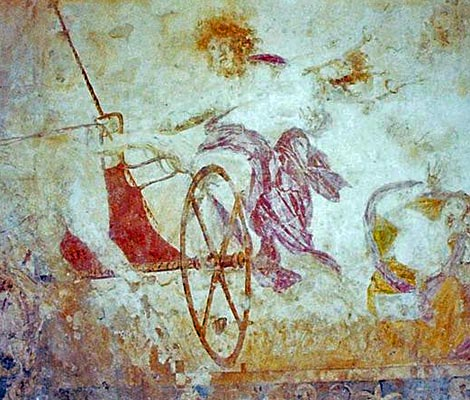By: Kayla Kandzorra
The ancient city of Aigai, now known as modern Vergina, is located in Imathia, 75 km from Thessaloniki. According to oral tales, the city was founded by Perdiccas I when the Macedonians of the Argive migrates north over the plain of Emathia. However, the site was first inhabited during the Early Iron Age (c. 1000-700 BCE). Aigai was the first ancient capital and cemetery of Macedonian kings, dating back to the 4th century BCE. As the capital of the Macedonian kingdom and site of the royal court, Aigai was the most important urban centre in the region throughout the archaic period and the following century. A large palace and mounds of cemeteries were located at Aigai. Greek architecture influenced the style of buildings at Macedonia, that included both Doric and Ionic forms. This influence illustrates how cultures interacted and diffused within each other. At Macedon there was constant changes of the the city states during this time, due to war and governments expanding. The capital was moved to Pella during the ruling of King Archelaus, but Aigai remained the custom burial ground for the Macedonian kings.
The tumulus at Vergina, consisted of three tombs and a heroon. The walls were plastered and painted with a long limestone slabbed roof. Even after being looted, the tombs remain important because they are preserved in exceptional conditions. Macedonian tombs are arguably a combination of Greek architecture and the influence of Doric structures. The exterior of the tombs resemble barrel-vaulted earthen mounds as opposed to traditional flat surfaces. The barrel-vaulted mounds with embellished facades may have been an observation made during the conquests to Asia by Alexander the Great. In the case of these tombs at Vergina, it was not possible to date the tombs because of the uniqueness of the structure. The interiors were decorated with paintings and reliefs, in addition to pillars and chambers. The remains of the artifacts are still highly debatable in terms of dating methods. It is important to understand that the study of royal tombs at Vergina is only a reflection of the royalty and upper class, and does not mirror the working class. Nonetheless, the abundance of wealth and density of the grave mounds affirms to the importance of Aigai during the 4th century BCE.
 |
| Rape of Persephone. Nikomachos. 340 BCE. |
The first tomb at Vergina was found to be robbed in antiquity. Outside of the tomb was a simple heroon, built for worship of the dead. The tomb itself was built from limestone in a cist grave style with no entrance, but a hole in the roof that was made later by looters. The roof was originally wooden, but only a limestone slab remains. The internal measurements of the tomb were 3.5 m by 2.09 m and a slab roof ceiling reaching 3 meters. The grave goods that were taken are unknown, but the human remains and some pottery sherds were left dispersed among the ground. Forensics have determined the remains to belong to a mature male, a much younger female, and a neonate. The walls were covered with frescos of the Rape of Persephone on the north wall; Demeter on the east wall; and three figures on the south wall. Beneath the plastered frescos is a blue framing of griffins. Frescos are paintings done in watercolour on wet plaster on walls or ceilings which had to be done quickly so that as the plaster dries, the paint remains stable on the surface. The most significant of these paintings is the the Rape of Persephone (shown above), commonly attributed to the famous Greek painter Nikomachos. It can be dated to 366 BCE, supported by the surrounding pottery. The painting depicts Hades, the god of the underworld, abducting Persephone, the goddess of grain, daughter to Demeter. Hades is seen controlling his chariot with one arm grasping the breast of Persephone. Persephone tries to escape, while her friend and herself shown in the frieze both have such lively emotions of terror and pain. Nikomachos shows extensive talent his time such as anatomically correct bodies, with an emphasis on facial emotions and body movement - which would reappear in later sculptures and art. Nikomachos only used four colours to paint; red, brown, yellow and purple, but achieved the correct shading to give amazing details. The colours must be prepared well in advance because the layers of paint on wet plaster would have to be done the day of. Specifically, Nikomachos showed curves and foreshortening of the wheel and draperies, such a task that was not easy to achieve. He used short, dark brushstrokes to suggest shading on Hades’ arm and Persephone’s torso, and throughout the fresco. The technique used had carved outlines and a unique muted palette, that deviate from the fresco-secco technique of later Macedonian wall paintings. This approach is uncommon because the outlines show the preliminary sketch outlining the scene. The fresco is important to art history because it was the first mythological scene known to have decorated Macedonian cist tombs.
No comments:
Post a Comment